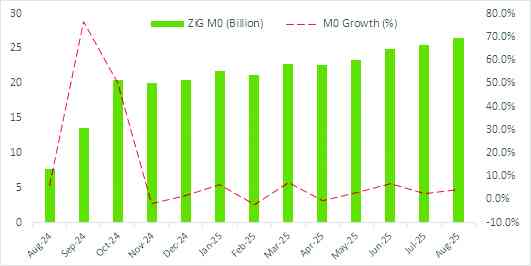
GENERALLY, economic agents must recognise the critical importance of economic analysis, as it provides the essential framework, data, and logic for making well-informed decisions about allocating scarce resources.
Relying on sound analysis transforms decision-making from mere intuition to a structured, objective process that maximises benefits and minimises costs.
In today’s fast-changing economic environment, the difference between success and failure depends on the ability to analyse and respond effectively.
That is why my column will diligently track and analyse key macroeconomic developments in October 2025, focusing on the political economy, legislative agenda, exchange rate and price inflation.
By equipping economic agents with this vital knowledge, I aim to empower them to navigate and thrive in a complex macroeconomic landscape, because understanding these developments is not just beneficial; it is essential for sustained success.
Political economy
Political stability is critical in creating a supportive environment for business success, profitability, and overall growth. However, since mid-September 2025, mainstream media reports have highlighted worsening factional battles within the ruling party, Zanu PF, and rumours of a military coup.
The political landscape has been further destabilised by calls for Constitutional amendments to extend Parliament and Presidential terms by two years, until 2030.
- Corruption Watch: Get scared, 2023 is coming
- Corruption Watch: Get scared, 2023 is coming
- Letters: Ensuring Africa’s food security through availability of quality seeds
- Is military's involvement in politics compatible with democracy?
Keep Reading
This has become Resolution One, originating from Zanu PF’s 2025 Conference held in Mutare in October 2025.
As a result, the party and the government have been instructed to begin the necessary legislative changes to implement Resolution One. However, many legal analysts have criticised this move, viewing these amendments as violations of constitutional procedures.
Legal experts argue that a referendum is required to amend presidential term limits and that the incumbent president should not benefit from the process.
In my view, these political developments threaten to plunge the nation into chaos, could hinder regional anti-sanctions advocacy, and may render the ongoing Structured Dialogue Platform with creditors ineffective.
All of these factors increase Zimbabwe’s investment risk premium and are likely to slow economic recovery and growth.
Legislative update
The parliamentary law-making process directly affects business operations, profitability, and strategic planning. Therefore, consumers and business leaders alike must stay informed about legislative developments, as this is a proactive way to manage risks, ensure compliance, influence policy and seize new opportunities.
In October 2025, President Emmerson Mnangagwa delivered the State of the Nation Address (Sona) and officially opened the third session of the 10th Parliament.
The Sona outlined the government’s regulatory reforms for 2025 and stressed the need to amend relevant Statutory Instruments and statutes to implement them.
The President urged Parliament to expedite legislative processes, directing the Third Session to resolve outstanding Bills from previous sessions.
These include the Mines and Minerals Amendment Bill, the Public Procurement and Disposal of Public Assets Bill, and the Insurance and Pensions Amendment Bill, among others.
Furthermore, President Mnangagwa expressed disappointment over Parliament’s failure to present previously announced Bills, emphasising that the backlog was unacceptable.
He then outlined the new Bills anticipated for the Third Session, spanning sectors such as commerce, real estate, education, transport, local governance and disaster management.
Money supply developments
The relative exchange rate and price stability observed year-to-date are mainly attributed to the Reserve Bank of Zimbabwe (RBZ)’s strong liquidity management and the Treasury’s fiscal discipline.
The latest RBZ data show a sharp decline in the growth of reserve money supply (M0), which is made up of currency in circulation and commercial banks’ deposits with the central bank. Monthly M0 growth fell from nearly 80% in September 2024 to below 5% in August 2025.
On average, M0 growth dropped from around 20% in June-December 2024 to 3% in January-August 2025, emphasising the Bank’s strict monetary targeting.
The sustainable M0 growth trend confirms that the relative price stability observed year to date is mainly due to the RBZ’s monetary discipline.
Looking ahead, with increased household and government spending expected in Q4, Zimbabwe Gold (ZiG) liquidity is likely to expand significantly.
This could exert downward pressure on the exchange rate, especially in alternative markets. Therefore, fiscal authorities are encouraged to resist this pressure by sticking to their approved budgets. In summary, fiscal restraint is essential for achieving monetary discipline.
However, it is important to note that the quality of the fiscal discipline mentioned earlier is questionable, as it is partly achieved through the Treasury’s failure to meet obligations when they are due.
For example, payment arrears are growing, surpassing US$1 billion. This poses a threat to the stability of government accounts in the coming months. Consequently, it presents a significant risk to the stability of the ZiG exchange rate and ZiG price inflation.
Exchange rate developments
In October 2025, ZiG appreciated by 0,9% against the US dollar (US$) in the official interbank market, ending the month at US$1:ZiG26,39, up from US$1:ZiG26.64 in September 2025. This marked four consecutive months of ZiG appreciation in the official market, with an average monthly gain of 0,5%.
Although the ZiG has decreased by 49,3% against the US$ in the official market since its launch (April 2024-October 2025), it has gained approximately 8,2% year-over-year (October 2024-October 2025).
It has also significantly reduced its losses, losing only 2,7% year-to-date (December 2024-October 2025). In parallel markets, the ZiG has remained range-bound [30-35] in October 2025, trading at an average of US$/ZiG 32.
The exchange rate movements in October 2025 indicate a stabilising local currency, as the average parallel market premium (the percentage difference between the official and parallel market rate) has dropped below 20%, the first time since the ZiG was introduced in April 2024.
This is commendable because a stable exchange rate offers businesses a predictable operating environment and safeguards consumer purchasing power, both of which are essential for fostering business growth.
Furthermore, given the government’s ongoing delays in paying suppliers and meeting export surrender requirements, a stable ZiG helps protect businesses against exchange-rate-related losses.
Looking ahead, I expect the exchange rate to stay stable in 2025 only if the status quo is preserved, that is, with fiscal restraint and monetary discipline. However, there are many downside risks to the US$1:ZiG exchange rate.
These include rising public debt, which has become unsustainable; deepening poverty and inequality, which subdue aggregate consumer demand; increasing informal business activities, which weaken the tax base, sustain dollarisation, and hinder government policies; persistent resource leakages (such as corruption and illicit financial flows); and growing fiscal spending pressures, especially for the input support during the 2025/26 agricultural season.
Additionally, the lack of a comprehensive, government-wide plan, along with insufficient fiscal tools and incentives to boost ZiG demand and use across all sectors, will prolong exchange rate fragmentation, weaken ZiG’s appeal, and reduce it to a transactional currency with minimal store-of-value use.
Furthermore, I remain concerned about the piecemeal approach the RBZ is taking to liberalise exchange rate management. While ongoing excessive intervention in the foreign exchange markets is currently effective, the long-term consequences are significant, as it entrenches substantial market barriers.
Therefore, monetary discipline must be reinforced by removing or reducing exchange rate restrictions and capital controls such as surrender requirements.
Inflation developments
Inflationary pressures continue to ease. Latest ZimStat data for October 2025 show that the ZiG inflation rate, as measured by the all-items Consumer Price Index (CPI), erased 0,2 percentage points from its September 2025 outturn, settling at -0,4%. This solidifies two straight months of deflation (negative inflation).
Further analysis of the data shows that ZiG price inflation has averaged 1,4% per month so far in 2025. On a year-on-year basis (October 2024-October 2025), ZiG’s inflation rate erased a staggering 50 percentage points, closing at 32,7% from 82,7% in the prior month.
The collapse in YoY inflation outturn was expected, as it indicates waning base effects stemming from the currency switch-over instituted in April 2024. The decline is in line with low ZiG MoM inflation, which has averaged 5% in the last 12 months or 0,4% over the previous nine (9) months.
In US$ terms, the MoM inflation rate for October 2025 was estimated at 0,3%, up from 0% recorded in September 2025. The slight uptick in US$ MoM inflation is primarily attributed to an increase in food and non-alcoholic beverages inflation, which rose by 0,2%.
This category alone constitutes slightly over 30% of the entire all-items consumer basket tracked by ZimStat. On average, the MoM US$ inflation rate stands at 1,2% so far in 2025. Also, the YoY US$ inflation rate for the month was estimated at 13%, down from 13,4% realised in September 2025.
In the outlook period, I expect YoY US$ inflation to continue decreasing. Its sharp rise to double digits was probably due to earlier RBZ exchange rate controls, which forced businesses to set prices based on official interbank rates that were significantly overvalued at the time.
However, the RBZ has since removed these controls and allowed the use of rates above the official ones in pricing goods and services. I also believe ZiG disinflation will persist, in line with the stabilising exchange rate. Regarding risks, we see them as fairly balanced: official data, such as a rebound in agriculture, a surplus in the balance of payments, and increased foreign currency inflows, support a downward trend in inflation.
Still, rising fiscal pressures, increased informal activity, debt unsustainability, deep structural rigidities and global geopolitical tensions limit the chances of further declines.
- Sibanda is an economist employed at Maxiquantus Capital Investments and Advisory. His perspectives are independent and do not necessarily reflect the views of his employer.—[email protected].











